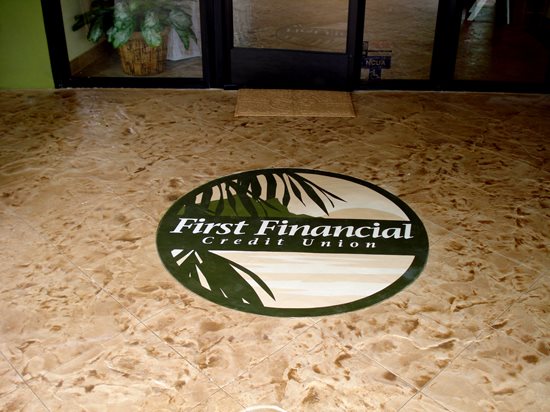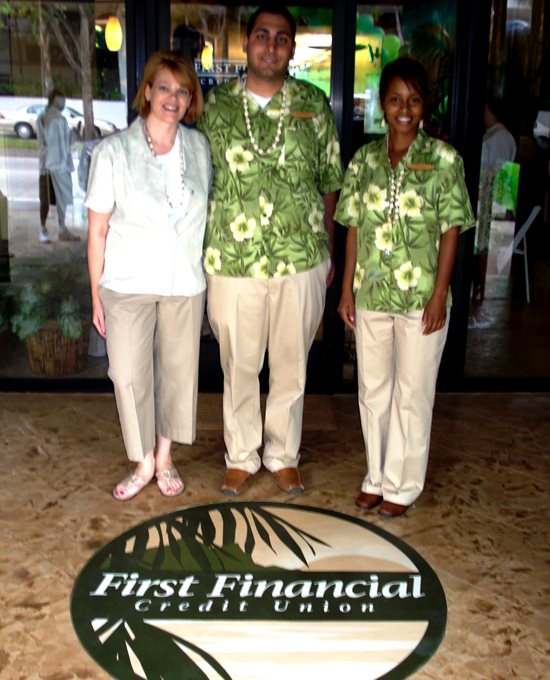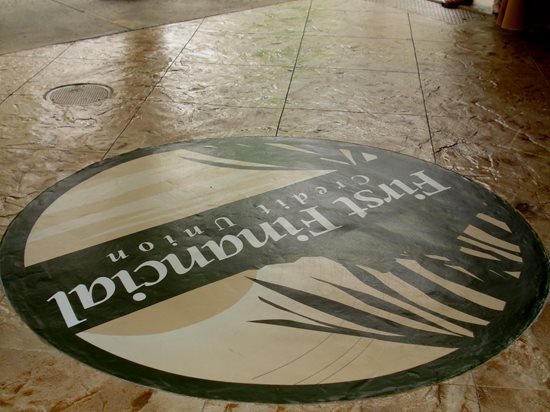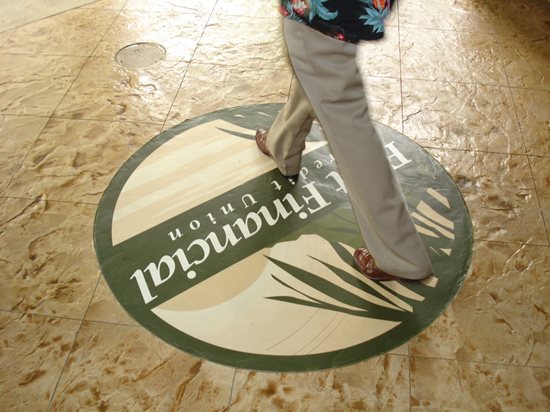- Stenciling Floors Home
- Stenciled Floor Pictures
- How to Stencil Concrete Floors
- Creative Ways to Use Stencils
- Stenciling Design Ideas
- Concrete Logos and Graphics: Creating images in concrete
- Adhesive Stencils
- A New Way to Stencil Concrete
- Related Information
- Concrete Stencils for Exterior Concrete
- Common Questions about Concrete Floors: Are they cold? Are they loud? Are they expensive? for Exterior Concrete
Logos in Concrete
Logos printed on self-adhering vinyl can be applied to concreteFor a quick and low cost, but also attractive and effective, way to provide a logo on a concrete floor, consider using a digital image printed on vinyl. "We had originally intended to sandblast the logo for the new entry way at the First Financial Credit Union," says Glen Roman with Staintec, but objections from a couple of nearby restaurants, and the need to get the floor completed quickly led to a different approach. "It was very simple—it just took a phone call to Adage Graphics."
"All we need is a file using any of the typical art applications," says Cindy Maloney, Adage Graphics. We can work with Illustrator or Photoshop files. That means the file types can be eps, ai, psd, tif, jpg, pdf, or quark QXD file. The ones that are difficult are things like Word or PowerPoint."
The file needs to be at a high enough resolution, says Maloney, that it will still be at 100 dpi when it's been enlarged to the final size. The vinyl that the image is printed on is 54 inches wide, but with some space needed to clamp the material into the printer, the maximum width of the image is 52 inches. Larger graphics can be accomplished by creating tiles of an image that are positioned next to one another. "When one is laid down then you position the next one so the images line up properly then you trim them together," she says, "cutting through both at the same time so that the graphics line up accurately. There's usually about an inch of overlap on the image."
In the case of the First Financial Credit Union logo, which is 48 inches in diameter, the original art had been created in Illustrator. "Since that's a vector image it was no problem to go up to the 48-inch size," says Maloney. "It's when you have a bitmap that you have to be concerned if it gets too big, since it will start to pixelate. We have the ability to res up an image that's close, but we still can't take a 1-inch wide 72 dpi image and expect it to go up to 4 feet wide."
On the credit union project, Staintec crews first stamped texture and applied color to the entire floor, then saw cut a grid pattern. Although the logo could have been applied to the textured floor, the bank personnel asked that the surface beneath the logo be made smooth, so Roman's crews used a cup grinder to flatten it out then applied sealer to the whole floor even in the circle where the logo was to go.
"When you get the artwork and are ready to install it," says Maloney, "you clean the area where it will be placed using just water—no solvents or waxes. Let it dry then position the graphic with the backing still intact so it's not going to stick down. Once it's in exactly the right place, tape it in one spot on the top or side. This piece of tape becomes your 'hinge.' Lift the logo around the hinge then peel away the backer starting closest to the hinge point and adhere it and smooth it as you peel away the backer. We use a plastic burnisher, but you have to be careful not to mar the surface since it's a semi-soft laminate. So use a plastic roller or a towel and rub your hand along it." Roman had no problem getting it positioned. "It bonded like wildfire."
The material that the logo is printed on is a vinyl that Adage then overlays with a textured floor laminate that can hold up to foot traffic and that has a nonslip finish. "The logo has about a 1-year lifespan," says Maloney. "This is not a permanent thing, like concrete, it's plastic that has been printed with a solvent ink. But at the end of the year you can warm it up with a heat gun and pull it up using a flat spatula, then clean off the residue and put down a new logo. So the image is replaced every year or so, but that also allows the company to change the image without having to tear up the concrete."
The cost of this type of logo depends on the size. The base price is $11.25 per square foot but the price decreases on larger pieces.
Submit Your Own Project Photos
Learn more about logos and graphics in concrete








